One-Step Non-Contact Additive LIFT Printing of Silver Interconnectors for Flexible Printed Circuits
Abstract
:1. Introduction
2. Materials and Methods
3. Results and Discussions
3.1. The Donor Films Characterization
3.2. Visualization of Surface Topography
3.3. Chemical and Phase Compositions
3.4. Electrophysical Properties
4. Conclusions
Author Contributions
Funding
Institutional Review Board Statement
Informed Consent Statement
Data Availability Statement
Acknowledgments
Conflicts of Interest
References
- Pal, R.K.; Farghaly, A.A.; Collinson, M.M.; Kundu, S.C.; Yadavalli, V.K. Photolithographic micropatterning of conducting polymers on flexible silk matrices. Adv. Mater. 2016, 28, 1406–1412. [Google Scholar] [CrossRef]
- Peng, C.N.; Wang, C.W.; Chan, T.C.; Chang, W.Y.; Wang, Y.C.; Tsai, H.W.; Chueh, Y.L. Resistive switching of Au/ZnO/Au resistive memory: An in situ observation of conductive bridge formation. Nanoscale Res. Lett. 2012, 7, 559. [Google Scholar] [CrossRef]
- Wu, B.; Kumar, A. Extreme ultraviolet lithography: A review. J. Vac. Sci. Technol. B 2007, 25, 1743–1761. [Google Scholar] [CrossRef]
- Sopeña, P.; Fernández-Pradas, J.M.; Serra, P. Laser-induced forward transfer of low viscosity inks. Appl. Surf. Sci. 2017, 418, 530–535. [Google Scholar] [CrossRef]
- Wang, X.; Xu, B.; Huang, Y.; Zhang, J.; Liu, Q. Laser-induced forward transfer of silver nanoparticle ink using burst technique. Appl. Phys. A 2019, 125, 845. [Google Scholar] [CrossRef]
- Fernández-Pradas, J.M.; Sopeña, P.; González-Torres, S.; Arrese, J.; Cirera, A.; Serra, P. Laser-induced forward transfer for printed electronics applications. Appl. Phys. A 2018, 124, 214. [Google Scholar] [CrossRef]
- Khan, S.; Ali, S.; Bermark, A. Recent developments in printing flexible and wearable sensing electronics for healthcare applications. Sensors 2019, 19, 1230. [Google Scholar] [CrossRef] [PubMed]
- Rapp, L.; Constantinescu, C.; Larmande, Y.; Diallo, A.K.; Videlot-Ackermann, C.; Delaporte, P.; Alloncle, A.P. Functional multilayered capacitor pixels printed by picosecond laser-induced forward transfer using a smart beam shaping technique. Sens. Actuator A Phys. 2015, 224, 111–118. [Google Scholar] [CrossRef]
- Sones, C.L.; Kaur, K.S.; Ganguly, P.; Banks, D.P.; Ying, Y.J.; Eason, R.W.; Mailis, S. Laser-induced-forward-transfer: A rapid prototyping tool for fabrication of photonic devices. Appl. Phys. A 2010, 101, 333–338. [Google Scholar] [CrossRef]
- Xu, J.J. Plastic electronics and future trends in microelectronics. Synth. Met. 2000, 115, 1–3. [Google Scholar] [CrossRef]
- Rehman, Z.U.; Yang, F.; Wang, M.; Zhu, T. Fundamentals and advances in laser-induced transfer. Opt. Laser Technol. 2023, 160, 109065. [Google Scholar] [CrossRef]
- Delaporte, P.; Alloncle, A.P. Laser-induced forward transfer: A high resolution additive manufacturing technology. Opt. Laser technol. 2016, 78, 33–41. [Google Scholar] [CrossRef]
- Hussain, A.; Lee, H.L.; Moon, S.J. Sintering of Silver Nanoparticle Structures and the Pursuit of Minimum Resistivity. Mater. Today Commun. 2022, 34, 105159. [Google Scholar] [CrossRef]
- Khan, S.; Lorenzelli, L.; Dahiya, R.S. Technologies for printing sensors and electronics over large flexible substrates: A review. IEEE Sens. J. 2014, 15, 3164–3185. [Google Scholar] [CrossRef]
- Mathews, S.A.; Beniam, I.; Charipar, N.; Piqué, A. Laser induced forward transfer (lift) for direct-write fabrication and assembly of microelectronics. In Proceedings of the International Congress on Applications of Lasers & Electro-Optics, Orlando, FL, USA, 14–16 October 2018. [Google Scholar]
- Mailis, S.; Zergioti, I.; Koundourakis, G.; Ikiades, A.; Patentalaki, A.; Papakonstantinou, P.; Fotakis, C. Etching and printing of diffractive optical microstructures by a femtosecond excimer laser. Appl. Opt. 1999, 38, 2301–2308. [Google Scholar] [CrossRef]
- Inui, T.; Mandamparambil, R.; Araki, T.; Abbel, R.; Koga, H.; Nogi, M.; Suganuma, K. Laser-induced forward transfer of high-viscosity silver precursor ink for non-contact printed electronics. Rsc. Adv. 2015, 5, 77942–77947. [Google Scholar] [CrossRef]
- Makrygianni, M.; Kalpyris, I.; Boutopoulos, C.; Zergioti, I. Laser induced forward transfer of Ag nanoparticles ink deposition and characterization. Appl. Surf. Sci. 2014, 297, 40–44. [Google Scholar] [CrossRef]
- Song, L.; Xu, B.B.; Cheng, Q.; Wang, X.; Luo, X.; Chen, X.; Huang, Y. Instant interfacial self-assembly for homogeneous nanoparticle monolayer en-abled conformal “lift-on” thin film technology. Sci. Adv. 2021, 7, eabk2852. [Google Scholar] [CrossRef]
- Zacharatos, F.; Makrygianni, M.; Geremia, R.; Biver, E.; Karnakis, D.; Leyder, S.; Zergioti, I. Laser Direct Write micro-fabrication of large area electronics on flexible substrates. Appl. Surf. Sci. 2016, 374, 117–123. [Google Scholar] [CrossRef]
- Lim, J.; Kim, Y.; Shin, J.; Lee, Y.; Shin, W.; Qu, W.; Hong, S. Continuous-Wave Laser-Induced Transfer of Metal Nanoparticles to Arbitrary Polymer Substrates. Nanomaterials 2020, 10, 701. [Google Scholar] [CrossRef]
- Nastulyavichus, A.A.; Kudryashov, S.I.; Smirnov, N.A.; Rudenko, A.A.; Kharin, A.Y.; Zayarny, D.A.; Ionin, A.A. Nanosecond-laser plasma-mediated generation of colloidal solutions from silver films of variable thickness: Colloidal optical density versus pre-determined ablated mass. Opt. Laser Technol. 2019, 111, 75–80. [Google Scholar] [CrossRef]
- Nastulyavichus, A.; Kudryashov, S.; Tolordava, E.; Rudenko, A.; Kirilenko, D.; Gonchukov, S.; Yushina, Y. Generation of silver nanoparticles from thin films and their antibacterial properties. Laser Phys. Lett. 2022, 19, 075603. [Google Scholar] [CrossRef]
- Pohl, R.; Visser, C.W.; Römer, G.W.; Lohse, D.; Sun, C.; Huis, B. Ejection regimes in picosecond laser-induced forward transfer of metals. Phys. Rev. Appl. 2015, 3, 024001. [Google Scholar] [CrossRef]
- Feinaeugle, M.; Alloncle, A.P.; Delaporte, P.; Sones, C.L.; Eason, R.W. Time-resolved shadowgraph imaging of femtosecond laser-induced forward transfer of solid materials. Appl. Surf. Sci. 2012, 258, 8475–8483. [Google Scholar] [CrossRef]
- Gauri, B.; Vidya, K.; Sharada, D.; Shobha, W. Synthesis and characterization of Ag/AgO nanoparticles as alcohol sensor. Res. J. Chem. Environ. 2016, 20, 1–5. [Google Scholar]
- Gopiraman, M.; Deng, D.; Saravanamoorthy, S.; Chung, I.M.; Kim, I.S. Gold, silver and nickel nanoparticle anchored cellulose nanofiber composites as highly active catalysts for the rapid and selective reduction of nitrophenols in water. RSC Adv. 2018, 8, 3014–3023. [Google Scholar] [CrossRef]
- Prieto, P.; Nistor, V.; Nouneh, K.; Oyama, M.; Abd-Lefdil, M.; Díaz, R. XPS study of silver, nickel and bimetallic silver–nickel nanoparticles prepared by seed-mediated growth. Appl. Surf. Sci. 2012, 258, 8807–8813. [Google Scholar] [CrossRef]


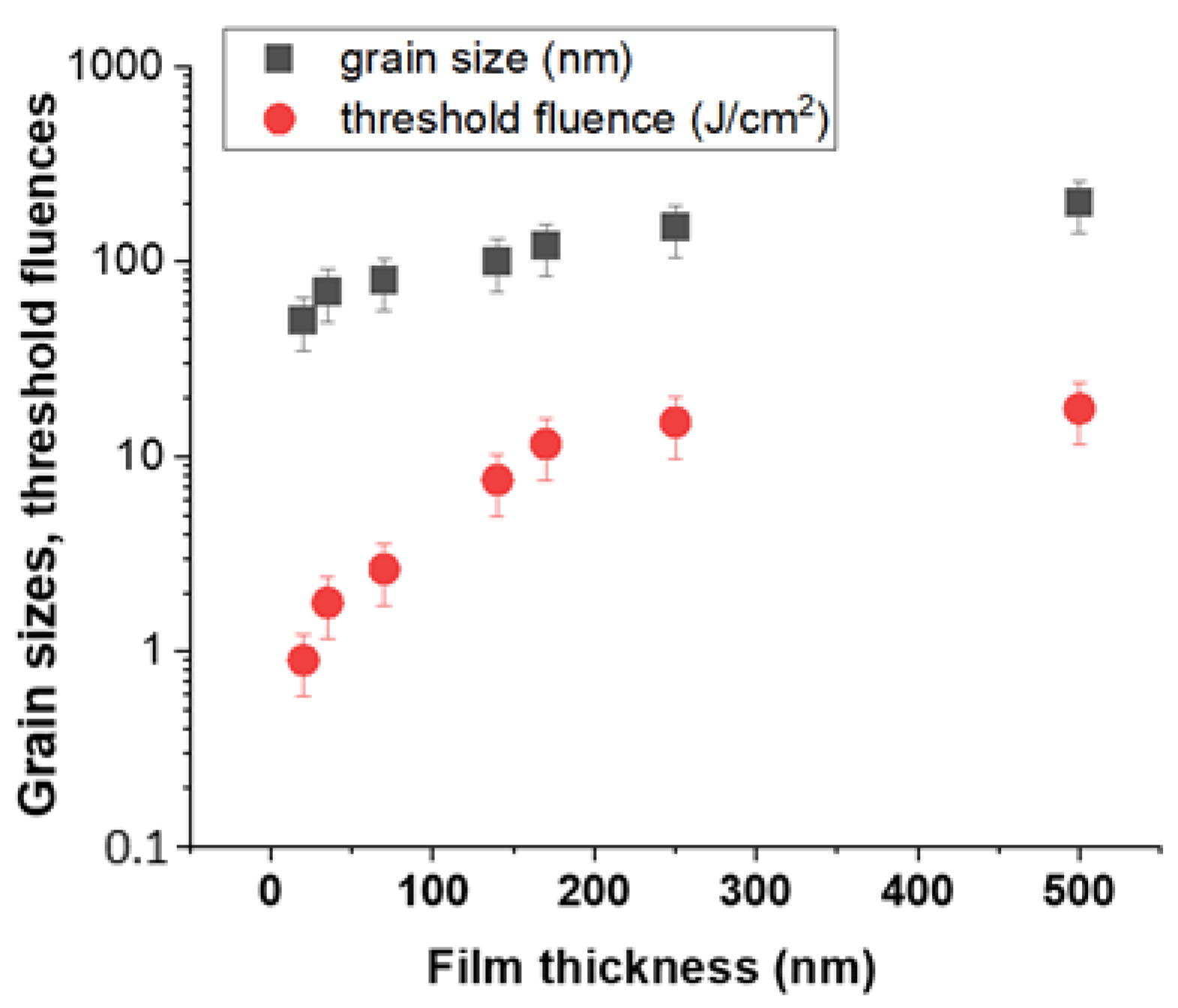
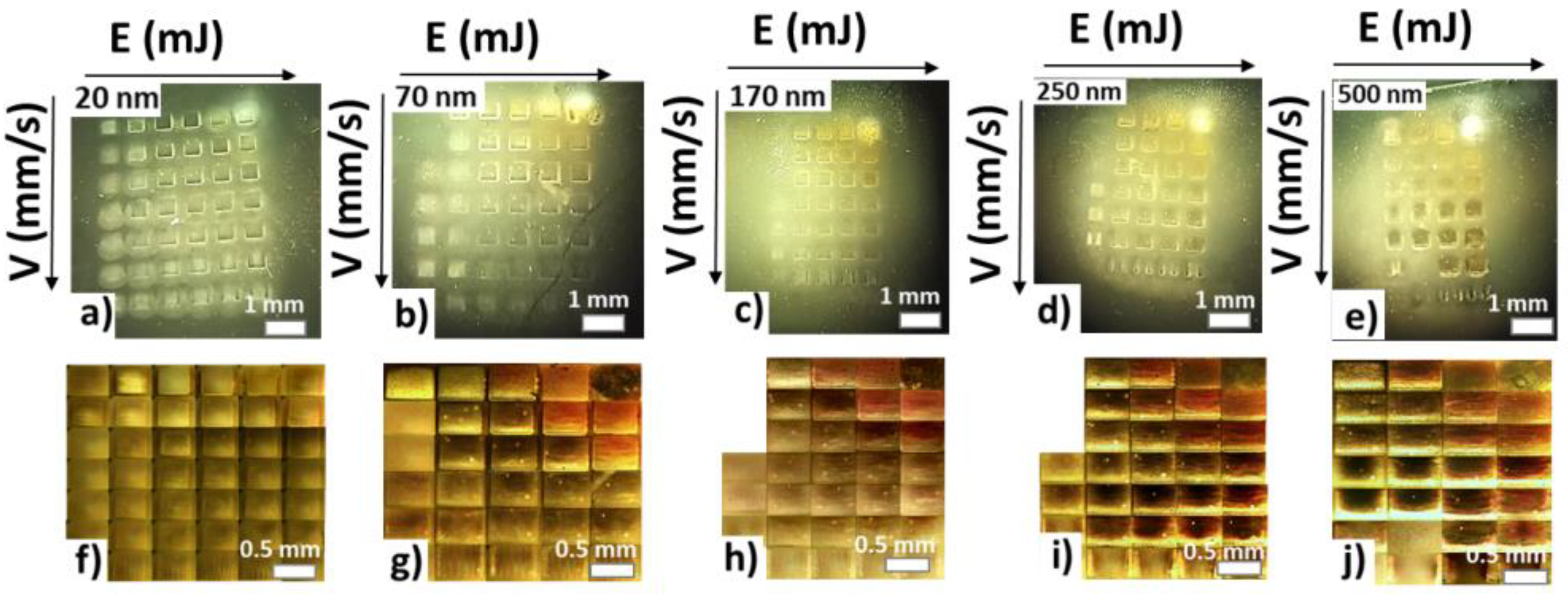


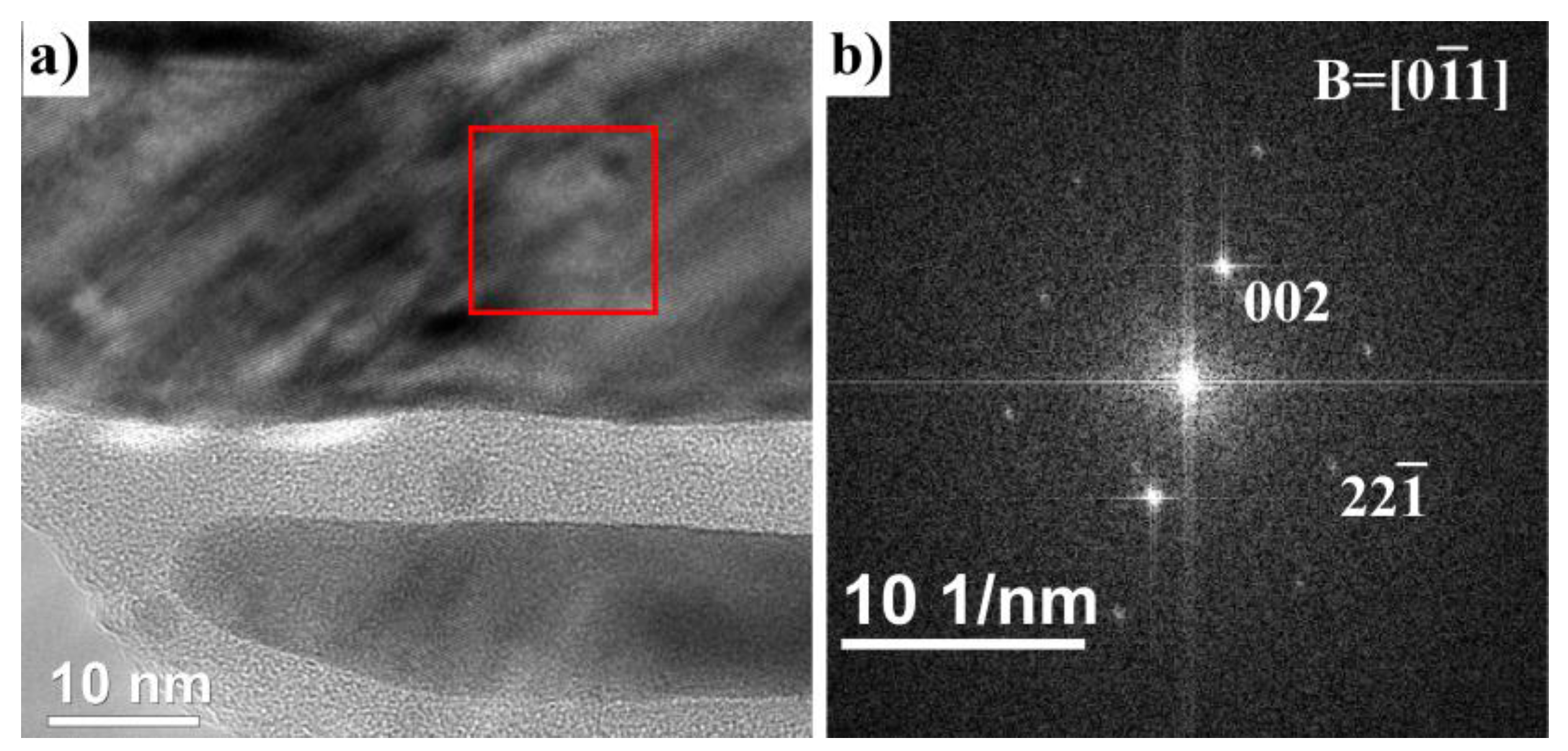

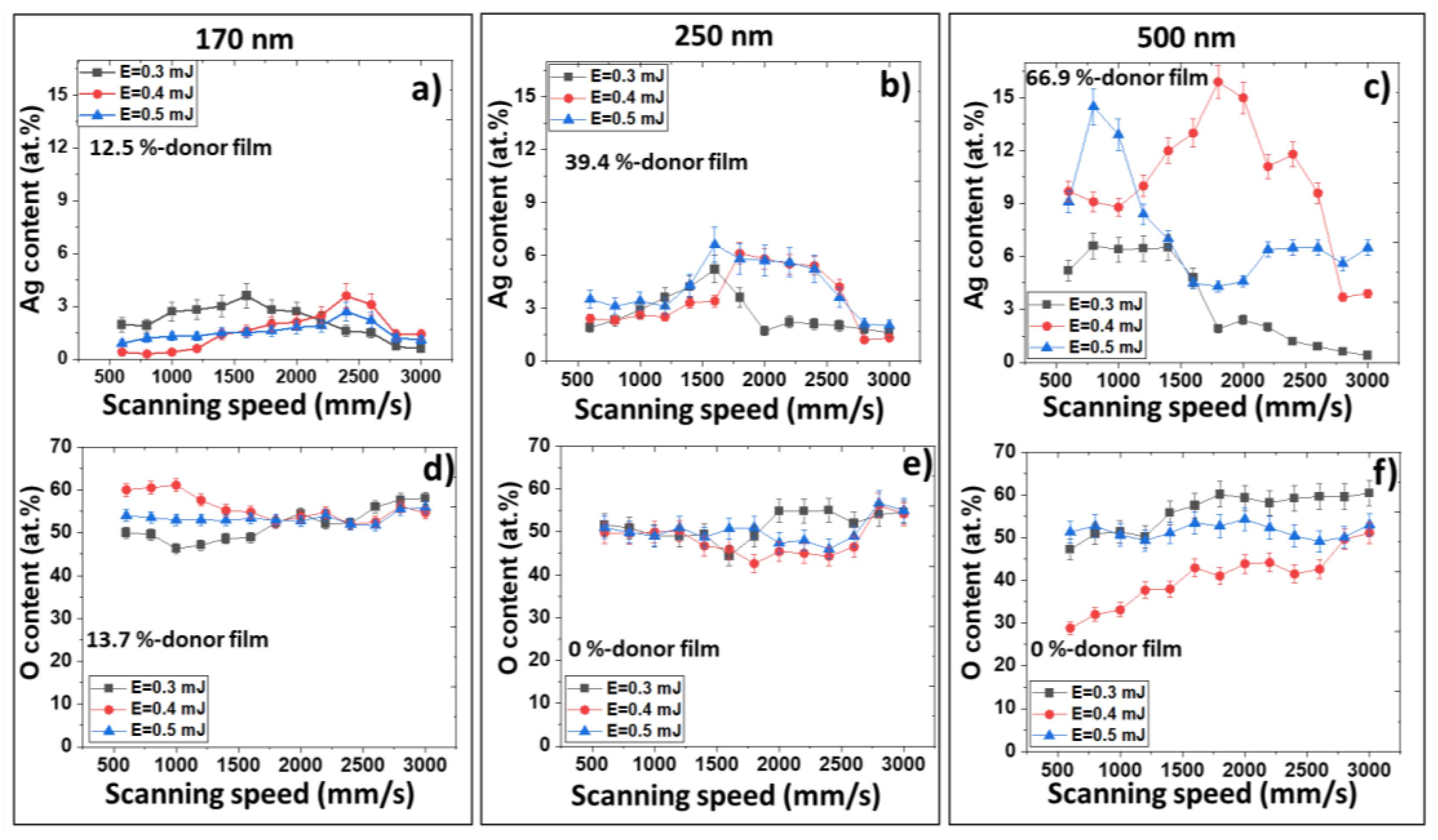

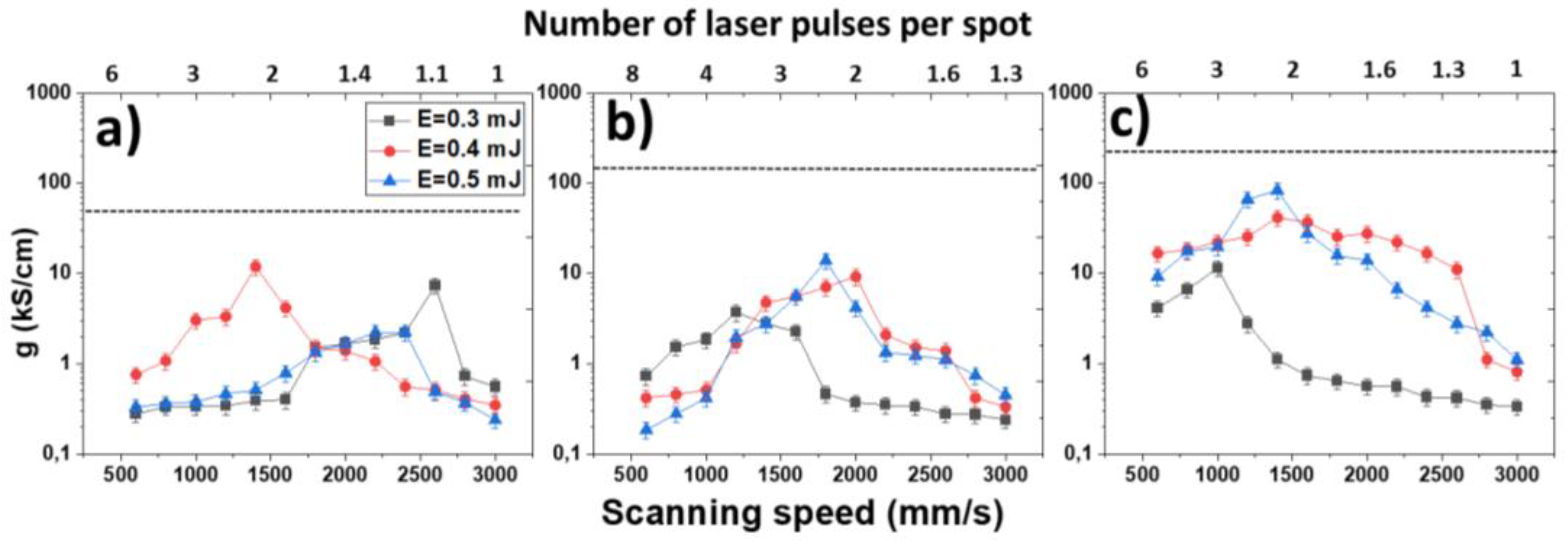
| Sample | Crystallite Size (111), nm | Crystallite Size (200), nm | Crystallite Size (220), nm | Crystallite Size (311), nm | Crystallite Size (222), nm |
|---|---|---|---|---|---|
| V = 1800 mm/s | 18 | 20 | 17 | 21 | 20 |
| V = 1000 mm/s | 16 | 13 | 14 | 19 | - |
Disclaimer/Publisher’s Note: The statements, opinions and data contained in all publications are solely those of the individual author(s) and contributor(s) and not of MDPI and/or the editor(s). MDPI and/or the editor(s) disclaim responsibility for any injury to people or property resulting from any ideas, methods, instructions or products referred to in the content. |
© 2024 by the authors. Licensee MDPI, Basel, Switzerland. This article is an open access article distributed under the terms and conditions of the Creative Commons Attribution (CC BY) license (https://creativecommons.org/licenses/by/4.0/).
Share and Cite
Nastulyavichus, A.; Kudryashov, S.; Shelygina, S.; Smirnov, N.; Pakholchuk, P.; Saraeva, I.; Zayarny, D.; Ulturgasheva, E.; Khmelenin, D.; Emelyanova, O.; et al. One-Step Non-Contact Additive LIFT Printing of Silver Interconnectors for Flexible Printed Circuits. Photonics 2024, 11, 119. https://doi.org/10.3390/photonics11020119
Nastulyavichus A, Kudryashov S, Shelygina S, Smirnov N, Pakholchuk P, Saraeva I, Zayarny D, Ulturgasheva E, Khmelenin D, Emelyanova O, et al. One-Step Non-Contact Additive LIFT Printing of Silver Interconnectors for Flexible Printed Circuits. Photonics. 2024; 11(2):119. https://doi.org/10.3390/photonics11020119
Chicago/Turabian StyleNastulyavichus, Alena, Sergey Kudryashov, Svetlana Shelygina, Nikita Smirnov, Petr Pakholchuk, Irina Saraeva, Dmitry Zayarny, Evgenia Ulturgasheva, Dmitry Khmelenin, Olga Emelyanova, and et al. 2024. "One-Step Non-Contact Additive LIFT Printing of Silver Interconnectors for Flexible Printed Circuits" Photonics 11, no. 2: 119. https://doi.org/10.3390/photonics11020119





